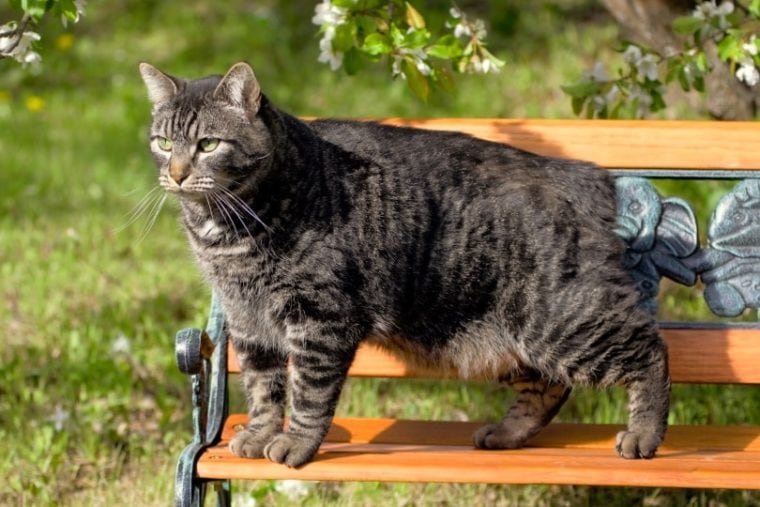
The Manx cat is an astonishing breed. Since this breed is popular worldwide, it helps to know a little about their past. From sailing the seas with Vikings to award-winning cat show performances, the Manx has a long history with the world, and today, we’re sharing it with you.
Let’s find out what makes the Manx so different from other cats.
What’s Special About the Manx Cat?
What’s unique about this breed is its tail—or lack thereof. A genetic mutation causes the lack of a tail. However, some Manx cats can have a tail. It really just comes down to how they were bred.
The Manx gene is incomplete, meaning it doesn’t always produce a no-tail cat. Two cats carrying the Manx gene can still create a Manx kitten with a standard tail. This is important because tailed Manx cats keep the breed healthy. So, you can find a lot of variety in this breed.
Manx cats can have long or short fur and come in various colors. Their fur is thick and plush, both for short and long coats. However, short-haired Manx cats have coarser and glossier coats.
When you observe a Manx cat, you’ll notice the body is round and sturdy everywhere. The head, body, and even hindquarters have a roundness to them. The eyes are round and wide-set.
Interestingly, the hind legs are longer than the front legs, so the Manx sits higher in the back. The back legs are known to be powerful, so watch out!

The Original Show Cat
Cat shows have been around for a while now. The first cat show was in London in 1871, and the Manx was one of the first cats represented in Great Britain. They were one of the founding breeds for the Cat Fanciers Association (CFA) cat show in the early 1900s.
Since the beginning of cat shows, Manx cats have continued to be cat champions and have increased in popularity.
There are some rules that Manx owners need to follow depending on the show and who’s hosting it. If your Manx has a tail, it can still compete in cat shows in a different category.
For instance, only a Manx cat with no tail or a rumpy riser (small tail nub) can compete in CFA cat shows. Manx cats with standard-length tails can compete in the All Other Varieties (AOV) class.
There are some cat shows that will only accept tailless Manx cats. Make sure you ask if your tailed Manx qualifies before entering.

Where Did Manx Cats Originate?
The Manx cat has been around for so long that it’s actually considered an ancient breed. Where did these kitties come from?
Manx cats originated on the Isle of Man in the Irish Sea between Ireland and England. It’s unclear how the Manx arrived at the Isle of Man. The belief is that the breed was introduced during The Viking Age. Manx cats left the ships when the Vikings docked and then mated with the native breeds.
By the 18th century, Manx cats were common almost everywhere. They helped keep mice away from farms, shops, and homes. Eventually, the long-haired Norwegian cat made its way to the Isle of Man, creating the long-haired Manx. These cats were considered working cats.
Folktales
You’re bound to find some fun folktales about how this breed came to be. One popular tale describes a Manx cat running late to Noah’s Ark. The Manx cat barely arrived in time, but Noah cut off the tail after he shut the ark door.
Another folktale talks about a tailless cat swimming ashore from a shipwreck. The cat supposedly stayed and bred with the other native cats.
If you’ve ever heard the term “the cabbit,” it comes from another folktale about the Manx breed. This third story suggests that a Manx cat bred with a rabbit and created a cat with no tail, long legs, and a round rump. This, of course, has never been proven.

Is a Manx Cat Rare?
The Manx cat is a declining breed in the Isle of Man but is not rare. You can find populations of tailless cats all over Europe, like in Cornwall and Crimea, although they may not be purebred Manx cats. However, in America, Manx cats are very popular.
You can find tailless cats in animal shelters everywhere. However, if you want a purebred Manx cat, you’ll have to find a reputable breeder.
Conclusion
Manx cats have been around the block and have exciting tales full of travel, adventure, and folklore. Most people know a cat is a Manx when they see that there is no tail, but Manx cats can have a tail, too! Check out the rest of the body for classic Manx features if you’re not sure.
These cats make excellent family pets, and now you know a thing or two about what makes them so great.
Featured Image Credit: rokopix, Shutterstock






